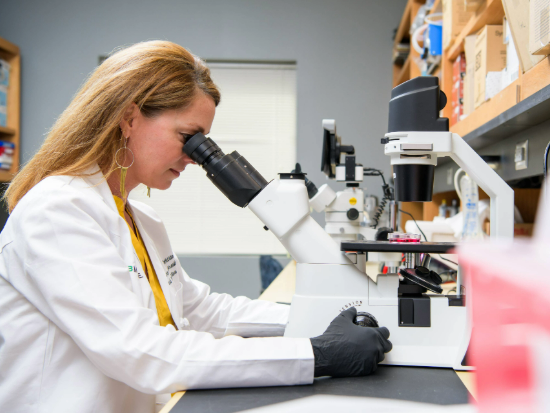 Dr. Jennifer DeBerry is a true rising star in pain research. Find out how her time at UAB shapes her current research and opens avenues to develop future endeavors.
Dr. Jennifer DeBerry is a true rising star in pain research. Find out how her time at UAB shapes her current research and opens avenues to develop future endeavors.
What drew you to the field of anesthesia research?
I’m a neuroscientist, and my primary research interest is pain. Because pain medicine is a subspecialty of anesthesia, pain research programs are often seated in anesthesiology departments. When I realized as an undergraduate that I was interested in pursuing a Ph.D., the late Dr. Larry Bradley offered me an opportunity in his lab—focusing on biopsychosocial factors associated with abnormal pain sensitivity. I found the notion that pain can be experienced despite an often-unidentifiable root cause and that “invisible” cognitive and affective factors can greatly influence one’s experience of pain incredibly interesting. The more I learned, the more my interest grew, and the rest is history.
Chronic or maladaptive pain is driven by changes within the nervous system that aren’t visible. I ultimately decided to pursue preclinical pain research in graduate school to mechanistically probe these changes. Drs. Tim Ness and Alan Randich supported that transition and continue, along with others, to reinforce my desire to do this work.
How have your collaborations in the field contributed to your growing recognition?
Collaboration comes in many forms and has played a fundamental role for me, both intellectually and practically. It brings together diverse perspectives and expertise, which drive more comprehensive and innovative studies. I’ve found that exchanging ideas across disciplines is intellectually stimulating and fosters creativity. Joint efforts often result in synergy, and none of us would be able to accomplish what we do if we functioned in silos without the input, influence, and help of others.
 What are some of the challenges you've encountered, and how did you address them?
What are some of the challenges you've encountered, and how did you address them?
Conducting scientific research inherently comes with challenges and requires perseverance and adaptability. That’s simply the nature of the game. Two general challenges come to mind: securing funding in a competitive environment and maintaining a reasonable work/life balance.
Grant applications are time consuming to generate, and submitting one comes with no guarantee of success. Both guidance from mentors and experienced colleagues and service on NIH study sections have been indispensable—offering me the opportunity to see the difference between what is perceived as a good versus great grant application, and for intellectual stimulation through exposure to forward thinkers in the field. My participation in the NIH Early Career Reviewer Program was particularly valuable.
A large challenge we all face is maintaining a reasonable blend of work and personal life. My son was born just a few months before I started my independent research career in this department. Sometimes, very late nights and early mornings spent working are imperative. But time is fleeting, and there’s nothing I’d trade for the moments I’ve put work aside for fulfilling times with my kiddo.
In what areas do you aspire to continue to grow as a researcher?
After nearly 10 years since starting my lab and 20 of doing basic science research, I’ve thought considerably for a few years about turning some of my effort toward clinical/translational research. Pain is incredibly complex, and while there’s no doubt that animal models are a highly valuable tool, I don’t believe they alone are the solution to “curing” chronic pain. There’s an incredible translational gap between scientific data and the development of novel interventions, despite ongoing efforts to understand and address this gap. There is significant inter-individual variability in the experience of pain and the aggregate of factors that contribute to it. I’m fortunate to be part of a department that is committed to interdisciplinary collaboration and have support from the REINVENT program to pursue this goal in clinical/translational work as an avenue of growth